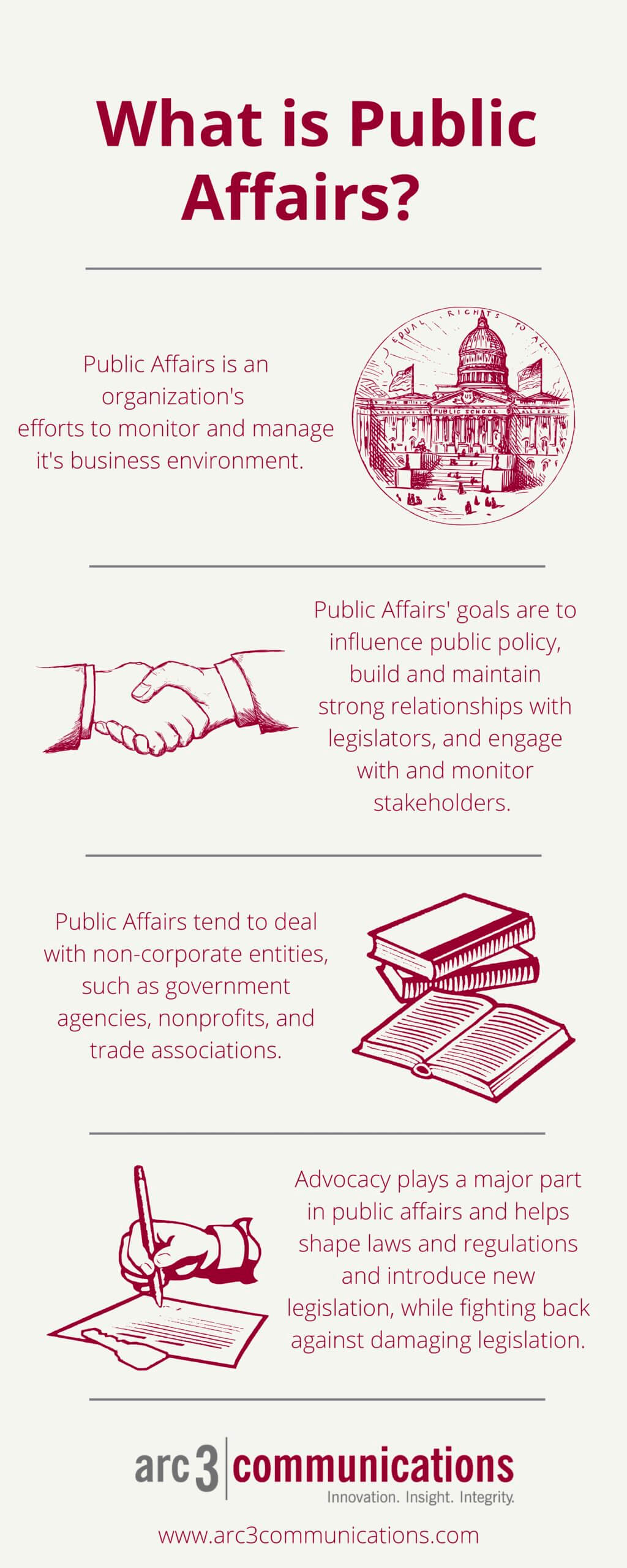The term “public affairs” is commonplace on the news and in government meetings, but what exactly is public affairs and what does it involve? Check out the infographic below to learn more about what public affairs is.

How to Hold Successful Virtual Meetings with Your Legislators
 Lobbying is a key aspect of any state’s legislative session. Traditionally, lobbying and advocacy involved going to the state capitol and forming and maintaining relationships in the attempts to persuade to have a bill passed or killed. This has changed drastically since the COVID-19 pandemic hit last year. Many state capitol’s have put in place limitations and restrictions to meet safety requirements during the legislative session. Many of the traditional ways to meet with lawmakers such as legislative receptions and special days at the Capitol have been taken off the table, leaving many lobbyists and citizens lost as how to participate in the legislative session.
Lobbying is a key aspect of any state’s legislative session. Traditionally, lobbying and advocacy involved going to the state capitol and forming and maintaining relationships in the attempts to persuade to have a bill passed or killed. This has changed drastically since the COVID-19 pandemic hit last year. Many state capitol’s have put in place limitations and restrictions to meet safety requirements during the legislative session. Many of the traditional ways to meet with lawmakers such as legislative receptions and special days at the Capitol have been taken off the table, leaving many lobbyists and citizens lost as how to participate in the legislative session.
Many new communication techniques have come into play since COVID-19 reared its ugly head. One is familiar to many, the virtual meeting. Zoom has become a commonplace in the daily life of many people. From business meetings to family visits, Zoom has been utilized to connect people during a time of social distancing and shutdowns. This includes communicating with legislators, and when doing so, you should know how to conduct the meeting.
Below are some tips and tricks for having successful Zoom calls with legislators during the legislative session and how to present yourself and make a lasting impression.
- Familiarize Yourself with the Virtual Meeting Software
If you are a frequent user of Zoom or Microsoft Teams you may be well versed in all the features and functions of the platforms; but if you are not, take time to learn before your meeting. The respective software websites and YouTube how to videos are great resources to ensure you know how the program works and the many features that it has. Be sure to know where the mute button, share screen button, chat button, and other items are located and how they work. Also be sure to understand how to join into a chat and how to make sure your microphone and audio is set upon entering a meeting. This way if you find yourself muted, you will know how to unmute quickly without keeping your legislator waiting while you try to figure it out.
- Keep Virtual Meeting Software Up to Date
A big item when using virtual meeting software, whether you use Zoom, Microsoft Teams, or any other form, is making sure you keep the software up to date. Check an hour ahead of your meeting time to make sure there are no last-minute updates that need to be made. You do not want the time to come around for your important call with a legislator only to be late because you had to spend time updating the software.
- Do a Visual and a Sound Check
It is important to login early to perform a visual and sound check to make sure your camera and microphone are working properly. There is a test feature on most virtual meeting software that allows you to record a short clip and play it back so you can hear how you sound to the other party. This will help you adjust levels as needed so you are not too loud or too quiet during a meeting. There is also the ability to test your camera and make sure you do not have any unwanted filters or backgrounds activated and that your lighting and positioning are ideal. Doing this before every meeting is a good idea in case there are any issues that need to be resolved prior to your meeting time.
- Avoid Silly Filters
A video went viral recently of a lawyer meeting with a judge on zoom and he had a cat filter turned on that made him appear in the meeting as a talking cat. While the video was amusing to those watching, this kind of mishap could cost you your credibility with a lawmaker. This is why it is best not to mess with these sorts of filters on a professional account that you use to conduct meetings. If you are unaware of how to deactivate these filters, it is best to not mess around with them at all, as once activated, they will remain activated on all future meetings until they are disabled manually.
- Use Backgrounds Wisely
Virtual backgrounds can be useful for helping to provide a more professional feel if you are calling from a home bedroom for example. Virtual backgrounds are images that can be downloaded and used to replace your actual background in a video call. It is wise to test these out before the call to make sure they work visually and don’t cause any hiccups or distractions. Sometimes, depending on the device you are using for the meeting, virtual backgrounds can glitch or not work at all. This is why it is always important to test anything you plan on using during the meeting, beforehand.
- Technical Issues Will Arise, Don’t Panic
Just like with all technology, it will work perfectly until you need it to. There are apt to be issues that are out of anyone’s control such as disconnects, lags, and other technical issues. Do not panic, do your best to ride out the issue and if you get disconnected, attempt to rejoin the conversation. If it gets to a point where the meeting is completely dropped, email or call your representative, apologize and see if he or she is willing to retry the meeting. If worse comes to worse, see if you can complete the meeting over the phone and apologize for any inconvenience. Again, things happen so don’t panic, do your best to resolve the situation and continue the meeting as best you can.
According to many, virtual meetings are here to stay. While lobbying and advocacy are most effective face-to-face, many legislators may take to virtual meetings as they can be more convenient, and they can fit more into a day. This isn’t to say you should not try to schedule in person meetings in the post-pandemic world, just be aware that lawmakers may prefer this method far into the future.
Need help designing a Zoom background for your organization or brushing up on your virtual advocacy messaging, content and presentation skills? Contact us here.
Ways to Mobilize Your Community to Support Your Cause
When it comes to making a change in your community, the most powerful tool you have is the community itself. How you can mobilize your community has evolved with the growth of social media, but many of the traditional methods still remain most useful. In fact, all of these tactics should be used together to bring awareness and organize your community to support your issue and gain the attention of your elected officials. This article will explore what is known as “slacktivism,” a form of social media engagement regarding a cause, and traditional tactics to bringing attention and action to an issue.
Slacktivism
In our age of social media, many issues become viral social media campaigns resulting in shares, comments, likes, and views but most of the time, little else. This isn’t to say “slacktivism” is entirely useless, in fact, it does raise awareness of an issue and can even inform people and get people talking about the subject. The problem lies in that these campaigns alone rarely result in action being taken. People comment, like, and share or sign an online petition and feel accomplished, like they have done something to help the issue when, in fact, it takes much more effort than that. This is why the term is a combination of “slacker” and “activism” because not much effort goes into participating in these online interactions and involvement often ends there.
This does not mean that online advocacy is useless, as previously stated, it can work wonders in raising awareness and spreading a message further and faster than many traditional forms of information sharing. It becomes hindered when it ends with this social media step. When people hit share and feel they have done enough and then move on. In turn, if it goes on to spark action and mobilization in the non-digital world, then it can be measured as a useful tactic. Online advocacy should be viewed as a tool, and not a complete solution to driving your issue.
Traditional
The traditional ways are still the most effective for mobilizing your community. Traditional methods are complemented and enhanced by the online and social media aspects we have in the digital age, but the tried and true forms of raising awareness and prompting action still hold strong. As stated before, engagement efforts must be utilized offline in the community itself to see real results. Writing letters and direct mail, volunteer phone banking, going door to door, and organizing local precinct level meetings are proven ways to reach the people of your area and really add voices to your cause. These tactics allow you to know that you are reaching the population you intend to reach and also allow you to form relationships that will benefit your cause in the long run. These traditional strategies combined with an online strategy will help mobilize your community. The effectiveness of your traditional and online strategies, however, hinges on a properly developed and crafted message. It is vital that your message informs and is credible and factual. You also want to be prepared to answer any tough questions that may be raised regarding your position and help alleviate any concerns among elected officials, the media and the public. Having a message that is factual and based on credible personal stories and sources goes a long way in building support.
In Conclusion
When bringing attention to an issue, both new and traditional tactics can be used together to mobilize your community, gain support, and ultimately bring about desired policy and legislative changes. Digital advocacy and social media campaigns are persuasive and bring awareness, while traditional measures bring people to concrete action within the community. A balance of these different tactics will help result in successful campaigns. These strategies used with a strong message, grab people’s attention and provide them with enough facts to make an educated decision to act. A community mobilized behind an issue is an extremely effective force in getting a legislative or policy change. In fact, it’s near impossible to get things done otherwise.
Need more advice or help?
For more information, visit us at www.arc3communications.com or contact Patrick Burns at pburns@arc3communications.com. We look forward to working with you to achieve your goals and help your voice be heard to bring positive changes to your community.
